

Pruning
At this time of the year commercial growers are busy with their pruning, aiming if possible to finish by early March in readiness for the first crop protectant sprays.
Below: apple bud at early stage
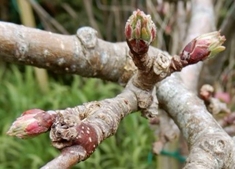 For the the home owner with an apple tree in the garden it is a very different proposition. To begin with what is the purpose of the apple trees? Are they intended to be a fruiting unit providing fruit for the family? Or are they something to enjoy as a source of blossom and scent in early summer, a place to hang the swing and a climbing frame for the children, with the bonus of a few apples straight from the tree in late summer. I was asked many times by visitors to my farm about pruning and I always asked those questions.
For the the home owner with an apple tree in the garden it is a very different proposition. To begin with what is the purpose of the apple trees? Are they intended to be a fruiting unit providing fruit for the family? Or are they something to enjoy as a source of blossom and scent in early summer, a place to hang the swing and a climbing frame for the children, with the bonus of a few apples straight from the tree in late summer. I was asked many times by visitors to my farm about pruning and I always asked those questions.
If your intention is to maximise the full potential, with plentiful fruit of good quality, it will require discipline and had work. If however it is more of convenience, then enjoy those branches which sweep across the tree in the wrong direction, spoiling the shape, but somehow adding a natural beauty which only freedom from a pruners saw can create. I have spent many a happy hour as a child climbing up into the top of a large Bramley tree, then sitting on a branch that should not have been there, enjoying the view of the surrounding countryside. It was great fun; even better in the company of a young lady!
For the commercial grower with large acreages to prune, pruning will have started as soon as the leaves are shed (mid November) and will not finish until spring time. In an ideal world the commercial grower would not start until after Christmas and would be finished and all pruning's removed or pulverised by the middle of February. This however is a utopian dream and rarely, if ever happens.
To create an efficient growing unit tree shape is important as light penetration is the key to crop load and quality. We are in effect 'harvesting' light. It is not just the fruit which needs good light to produce an attractive apple, the fruit bud which will deliver the flowers and our fruit, also needs good light, so the layout of the tree will determine the light interception.
The optimum commercial orchard will be populated with the maximum amount of fruiting wood; e.g. branches and fruit buds, without causing detrimental shading. To achieve this trees will be closely planted in the row to ensure the space between is quickly filled with fruiting wood and the tree height will be controlled to avoid shading the lower fruiting branches. The alleyway between the tree rows necessary for tractor movement is in ratio to the tree height to stop adjacent rows shading each other.
In my youth circa 60 years ago, our trees were either Standard trees some 25 feet high or Bush trees circa 15 feet high. All required a ladder and tools were hand held secateurs and pruning saw. In the 1970's we use a small 'chain saw' to speed up the removal of larder branches. The next innovation was pruning tools powered by an air compressor on the tractor.
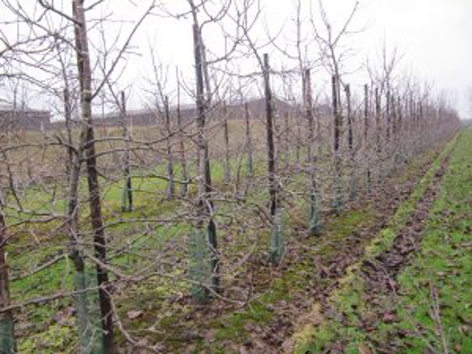
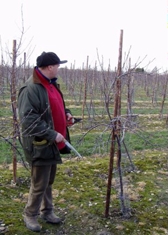 During the 1970's we grubbed the larger trees and replaced with modern 'spindle bush' trees planted at 4-6 feet in the row and rows 12 feet apart. Pruning was managed mostly from the ground or with the help of small step ladders.
During the 1970's we grubbed the larger trees and replaced with modern 'spindle bush' trees planted at 4-6 feet in the row and rows 12 feet apart. Pruning was managed mostly from the ground or with the help of small step ladders.
Many orchards today are still managed in this way.
Returning to tree management, varieties as well as rootstock play their part. A variety like Golden Delicious, dare I mention it without suggesting those green tasteless French ones are acceptable, is a very easy tree to manage with naturally wide angled branches. Many of the heavier cropping varieties have Golden Delicious in their parentage; Gala and Jonagold for example. These are easy trees to manage and can be planted very closely and kept under control, even in later years when the tree is fully mature.
As the apple industry grappled with the challenge of producing higher yields of quality fruit to compete with imports, progressive growers planted 'hedgerow systems'
Below: Hedgerow system at Adrian Scripps Ltd. at harvest time
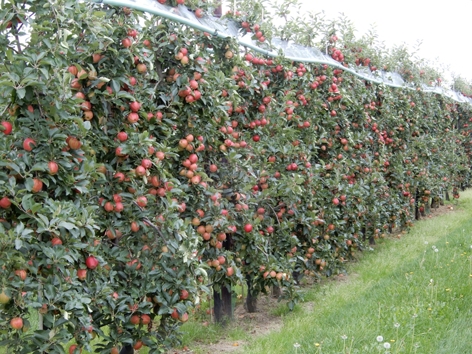
The most up to date apple growers now use electric secateurs and mobile platforms to prune the trees above head height.
Below: Radu Tandarescu shows Government Minister Victoria Prentiss the REVO harvest platform at the National Fruit Show
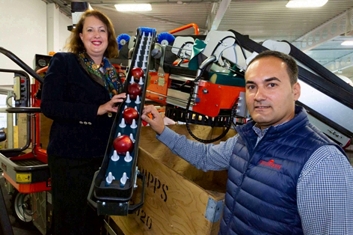 The English Apple Man in conversation with Radu Tandarescu, Farm Manager at Adrian Scripps Ltd. Parsonage Farm asked, is this your operating procedure across all farms?
The English Apple Man in conversation with Radu Tandarescu, Farm Manager at Adrian Scripps Ltd. Parsonage Farm asked, is this your operating procedure across all farms?
"Yes, indeed. We have a team pruning from the ground with electric secateurs, and another following with REVOs to cover from the middle of the tree to the top".
The trees would have between 3.2-3.5 metre height, we have standardised all orchards to better fit the 3-row sprayers as well.
We have eliminated all the ladders as we have found them very dangerous for the pruners, with also high maintenance costs".
Below: One man operating REVO platform pruning the upward section of the tree row. The platform is easily adjustable for optimum working height.
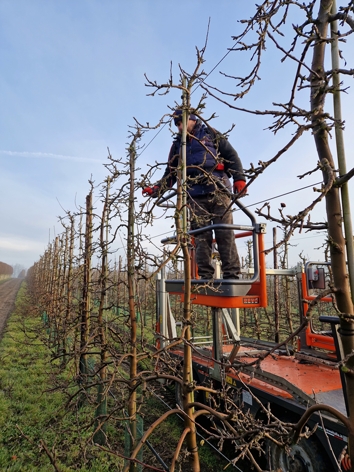
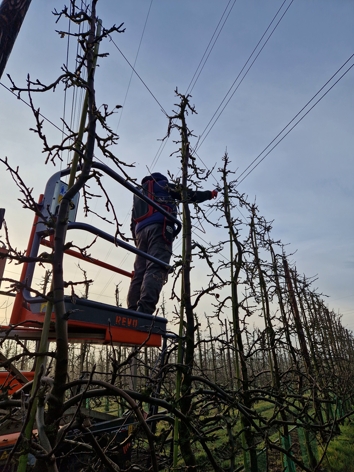
Adrian Scripps has 25 REVOs across all farms, all the ladders and picking buckets have been made redundant after the harvest of 2019 at Parsonage Farm in Cobham, and on the rest of the farms the year after.
The platforms are more efficient than ladders, as the pruners can work at a constant speed, there is no risk to accidents, no physical effort and dead time to carry the ladder and move from one tree to another.
Radu adds, "The REVOs are very well built, very easy to turn from apple harvesters into orchard platforms in a matter of minutes, to be used for all-year-round orchard tasks: pruning, orchard set up, wirework, thinning, tree tying etc.
The machines are supplied with a sturdy frame to securely move and store the picking conveyor kit after harvest.
REVO platforms/harvesters have become very popular around the world, with hundreds of machines actively sold in both hemispheres. We now cover the whole of UK, with customers from Herefordshire area to Suffolk, across Kent and Northern Ireland.
Click on REVO Pruning Video
Radu expands on Hortus Machinery Ltd.
"We sell them under Hortus Machinery Ltd., we keep good stock of parts at our premises in Cobham to cover all our customers.
We offer full staff training to all customers and 24/7 technical support, including instant response for callouts.
We have a great relationship with the manufacturer, and regular visits to the factory to discuss over the potential issues and continuous improvements on the machines" .
Below: REVO platform in harvest mode
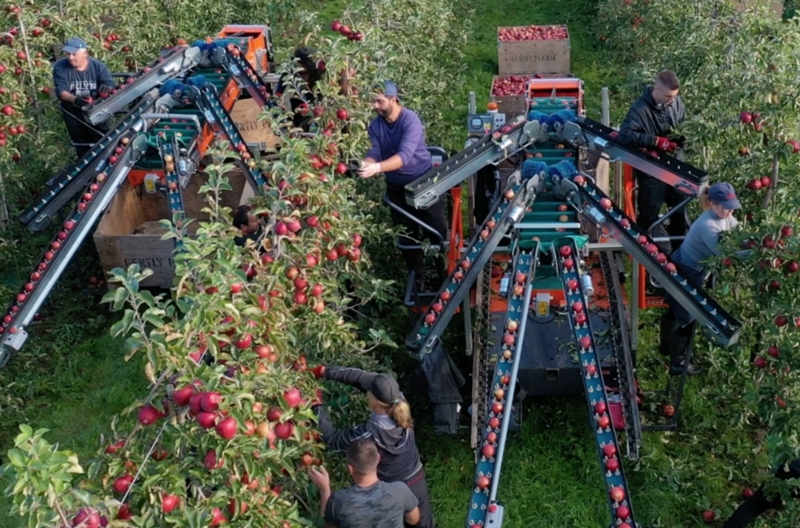
Click on HORTUS Machinery website
Click on: Pruning Cox circa 2010
Click on: Pruning Braeburn and Gala circa 2010
A blast from the past!
While looking back at previous English Apple Man Journals for past passages on Pruning, I came across this gripe I made circa 10 years ago: "It is in my opinion quite scandalous, especially as our Government Ministers are 'pontificating' about the need for The UK to be more self sufficient.
With my growers hat on I get very uptight listening to 'prattling politicians' who have reduced our valuable research funds to, by what has been in annual government budget terms, 'chickenfeed' while passing on much greater sums to umpteen unnecessary quangos!
Nothing changes!
Take care
The English Apple Man